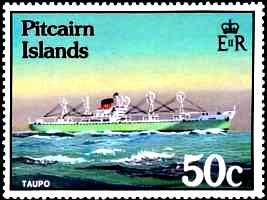
|
Maritime Topics On Stamps :
The Demise of Break-bulk Shipping!
|
|
The topic here is break-bulk and general cargo ships of the 20th century,
followed by the developments to specialized vessels which spelled the end for
traditional general cargo freighters.
|
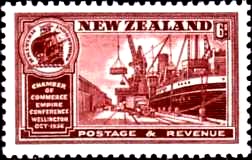
|
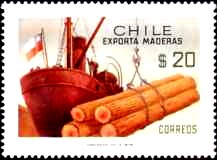
| |
Ship’s cargoes are basically identified as either ‘general cargo’ (or
‘break-bulk’) and ‘in bulk’. The latter is further divided into ‘dry’ and
‘liquid’ cargo.
Break-bulk are shipments consisting of either single pieces or loaded in boxes,
bags, drums, cartons, or on pallets. So are automobiles, locomotives, steel
parts, cut lumber as well as loose logs, boilers, copper bars, etc. These
goods, defined as ‘lots’, are sent off by shippers utilizing freight
forwarders and brokers.
|
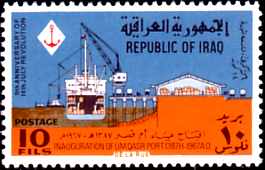
|
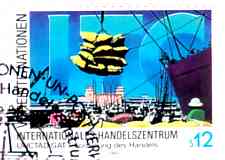
| |
General cargo trades are roughly categorized as either liner service or tramp
shipping. Most break-bulk is shipped on liners, i.e. vessels with scheduled
sailings serving fixed routes such as North West Europe to North America East
Coast (NWE/USEC). Most shipping companies are members of voluntary
‘conferences’ where rates were fixed and schedules assigned. In the 1960s,
there were some 200 ‘shipping conferences’ worldwide, all exempt from
international anti-trust and monopoly regulations. At the same time, some
owners elect to compete as ‘non-conference’lines, undercutting the
established liner companies (especially useful for East Block countries
lusting after hard currencies).
Tramp shipping knows no fixed routes or schedules, the ships are employed
wherever there are cargoes to be moved. Therefore most of these shipments are
in bulk.
|
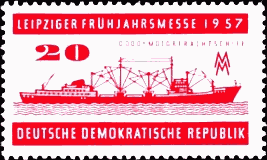
|
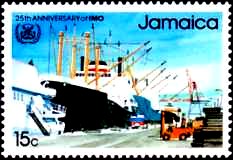
|
| MV 'Frieden', built 1957, L-518 ft, 10.020 tdw |
Cargo handling with ship’s derricks. |
|
Proper stowage of general cargo was ‘an art form’ due to the different
dimensions, weights, characteristics -- and the order of the various ports
served on a given route. A break-bulk freighter had several holds, or
‘hatches’, which in turn were subdivided with tweendecks, as seen on the
Iraqui stamp above. The majority of non-European ports were still without own
loading/discharging facilities by mid-20th Century. So, freighters had
extensive cargo handling gear, two or four derricks, or ‘booms’, per hatch,
or sometimes one or two cranes. Most booms lifted loads of three to five
tons. In addition, there often was a heavy-lift boom with lifting capacity of
20-50 tons. Being on a fixed schedule, most general cargo vessels were rather
fast with 15-17 knot speeds compared to slower tramp vessels. The process of
discharging, loading, and securing (‘lashing’) of break-bulk cargo usually
required several days in port, much enjoyed by the ships’ crews.
|
|
Break-bulk shipping has been around since the beginning of times. General
cargo was transported in dugouts, by Phoenician traders, and with the
galleons of the Dutch and British East Indian Companies. Yet, the term
‘break-bulk’ denoting a certain species of ships was only coined this past
Century. Stamp at right shows the 1911 German-built steamer ‘Adelaide’, here
as ‘Cunene’, her name under later Portuguese ownership. Some specs: length
540 ft, beam 58ft, draft 25ft, 5,875 GRT, 12 knots.
|
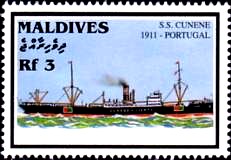
|
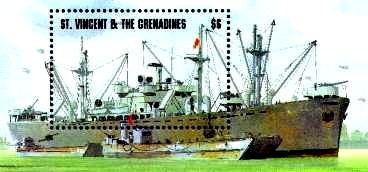 |
World War II’s most important and famous general cargo vessels were the
Liberty and Victory types built in American and Canadian yards. Their main
purpose was the delivery of war materials and provisions to the United
Kingdom and the Soviet Union. A Liberty had five hatches, 10,500 DWT, was
443 ft long, with a 56 ft beam and a speed of 11 knots. 2,751 Liberties were
commissioned between 1941 and 1945; today there are just two of them left in
sailing condition (and one Victory vessel). Their full story may be read on
our page covering ‘The Battle of the Atlantic’.
|
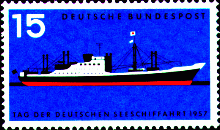
|
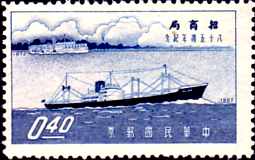
|
Here two examples of the fast cargo liners of the 1950s and 60s. The German
stamp depicts six sisterships built in the mid-fifties, three for the NGL
(‘Bayernstein’,‘Hessenstein’, ‘Schwabenstein’), and three for HAPAG
(‘Hamburg’, ‘Hannover’, ‘Frankfurt’), employed in the N.W. Europe/East
Asia trade.
Some specs: Length 538 ft, beam 64 ft, draft 26 ft, 5 holds, 17.3 knos, 11,659
DWT, 87 passengers.
The Chinese stamp shows M/V ‘Hai Min’, built 1957, 433 ft long, 11,659 DWT,
14.5 knots.
Typical configuration for freighters of this size, with three holds forward
and two aft of the midships superstructure.
(To distinguish these venerable general cargo ships from the later species of
Ro/Ro vessels, some ‘expert’ came up with the term ‘Lo/Lo’ = ‘Lift on/Lift
off’ ships.)
|
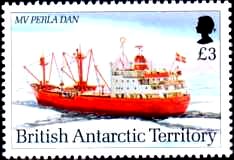
|
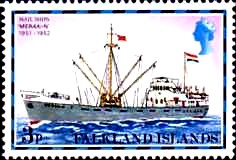
|
These two specimen were adapted to specific regional services. Left,
Lauritzen Shipping Co.’s ‘Perla Dan’ employed in Antarctic waters. Fully
ice-strengthened, she also sports a crow’s nest on the forward mast. 213 ft
long, 1,250 DWT, 12 knots.
On the right we see the ‘Merak-N’, a Dutch coaster on charter to the
Falklands Islands Co. Served as mail boat and moving general cargo around the
islands. 213 ft long, 36 ft beam, 11 ft draft, 817 GRT. Built 1949 in the
Netherlands.
|
And now onwards to the ‘special types’:
|
Here we see the Russian M/V ‘Vladimir Ilyich’, 497 ft long, 66 ft beam, 24 ft
draft, 13,150 DWT, 17 knots. Built 1970 in Warnemünde, in the former 'GDR'.
A typical example of general cargo freighters of the ‘70s when modern cranes
became standard cargo handling gear replacing old-fashioned derricks.
|
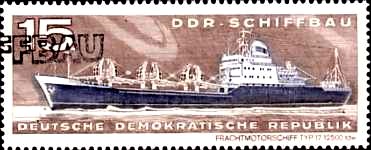
|
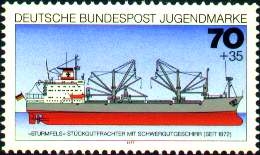
|
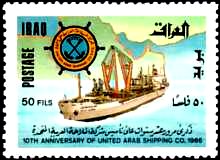
|
|
Both stamps depict heavy-lift vessels, equipped with one or two heavy-lift
booms.The right stamp shows the V-shaped masts supporting the HL boom,
pioneered and patented by Germany’s Stülcken shipyard. Such derricks have
lifting capacities of up to 125 tons. 1972-built M/V ‘Sturmfels’ of
Bremen’s Hansa Co., seen on the stamp at left, had two such HL booms, which
combined were able to lift loads up to 550 tons. Careful use of ballast tanks
was essential during loading and discharging. Some specs: 502 ft long, 75 ft
beam, 32 ft draft, 12,814 DWT, 20 knots.
|
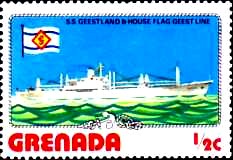
|
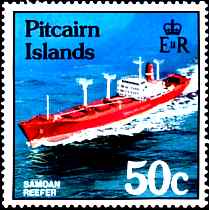
|
Reefer vessels with refrigerated cargo holds transport perishable cargoes
such as bananas, other fruits, orange concentrate in drums, chilled beef,
frozen meat or fish, etc. Temperatures may be varied from plus-8 degC for
bananas to minus-40 degC for frozen meats. Ships have usually more than one
tweendeck to protect their sensitive cargoes. Their speeds are rather fast,
around 18-22 knots.
The first ‘banana boats’ had side ports and stevedores carried individual
bunches into and out of the holds. Later on came conveyor belts and bunches
packed in cartons. The ships’ hulls are most often painted white, the better
to reflect the sun’s heat.
The Grenada stamp shows Geest Line’s 1972-built‘Geestland’, 489 ft long, 46 ft
beam, 28 ft draft, 7,630 DWT, 21 knots. On the right we see Lauritzen’s
1973-built ‘Samoan Reefer’, 477 ft, 68 ft beam, 29 ft draft, 8,941 DWT, 22.5
knots.
|
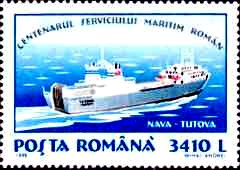
|
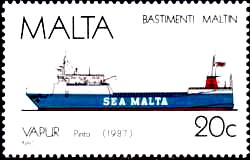
| |
‘Ro/Ro’ (=Roll on/Roll off) ships, as the term implies, are those with stern
ramps and/or side openings through which the cargo rolls into the vessel, and
then rolls off again in the discharge port. Anything on wheels can be taken
aboard, either rolling on its own or moved around by fork lifts, as with
goods strapped to pallets or with containers. Loading and discharge times are
short. There is no need for either cargo gear or rails.
The earliest Ro/Ro ships were train and automobile ferries, but gradually
became adapted for general cargo as well.Today’s stern ramps may swing out at
40 degree angles to either side and can support loads of up to 160 tons.
|
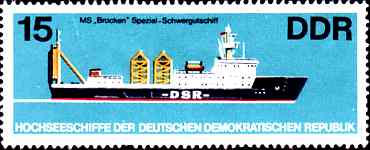
|
There are some vessels employing the convenience of Ro/Ro combined with
special gear for other uses. Here is a ‘Ro/Lo’ carrier with a stern ramp for
Ro/Ro cargo, and two mobile heavy-lift booms, each one capable of lifting 65
tons, for Lo/Lo units.
M/V ‘Brocken’, built 1975 in the Netherlands. 270 ft long, 54 ft beam, 13 ft
draft, 1,348 DWT.
|
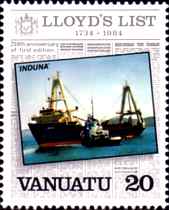
|
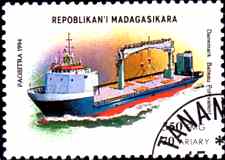
| |
‘Multi Purpose Carriers’ are transporting break-bulk and/or pure bulk
cargoes and/or containers, even reefer containers for frozen meats or fruits.
Loading and discharging is performed with the ships’ own cargo cranes. Hatch
openings are designed to accommodate standard container sizes (TEU,
Twenty-feet Equivalent Units). Variable height, removable tweendecks are used
for automobiles, removable longitudinal bulkheads prevent grain and other
bulk cargoes from shifting.
|
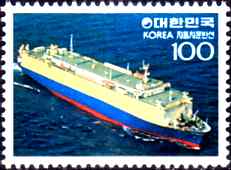
|
‘Multi Purpose Carriers’ are transporting break-bulk and/or pure bulk
cargoes and/or containers, even reefer containers for frozen meats or fruits.
Loading and discharging is performed with the ships’ own cargo cranes. Hatch
openings are designed to accommodate standard container sizes (TEU,
Twenty-feet Equivalent Units). Variable height, removable tweendecks are used
for automobiles, removable longitudinal bulkheads prevent grain and other
bulk cargoes from shifting.
| |
The stamp pictures the PCC ‘Hyundai No. 1’, built in 1980.
Here some
specs of one of the most modern car carriers, built 1999 in Korea. The
Wallenius owned PCC ‘Boheme’ is 653 ft long, with 106 ft beam, 36 ft draft, 13
decks, a capacity for 5,882 mid-size automobiles, 22,600 DWT and 57,018
GRT (due to its giant-size enclosed superstructure).
|
Of quite similar appearance, but presently not shown on any stamp, are huge
livestock carriers transporting live sheep from New Zealand and Australia to
Saudi Arabia. (Are they designated ‘Wo/Wo’=Walk on/Walk off, ‘To/To’=Trot
on/Trot off, or‘Mo/Mo’=Move on/Move off? ...or what?)
|
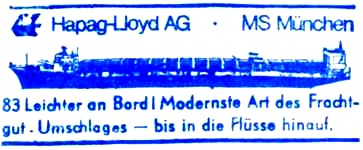 | |
The ‘LASH’ acronym means ‘Lighter Aboard Ship’, i.e. a vessel carrying
lighters or barges inside the cargo space. Loaded at far away locations, the
lighters are then towed to the mother ship and either float through bow
openings inside the hull or are lifted aboard with mobile shipboard cranes.
Discharge happens in reverse. Especially suitable for harbors in
underdeveloped regions and areas with shallow water depths.
The advertising stamp above shows the Hapag-Lloyd LASH vessel ‘München’,
built in 1972. In December of 1978 she disappeared with all hands in the
North Atlantic somewhere north of the Azores. Some specs: 856 ft long, with 105 ft
beam, 36 ft draft, 18 knots, 43,000 DWT and crane lifting capacity of 465
tons. 83 lighters of 19x9x4m, weight approx. 87 tons.
Other LASH type vessels are known by their acronyms BACAT = Barge Catamaran
Transport, and BACO = Barge Container ship. For some 20 years already, three
such German ‘Bacoliners’ are sailing in the N.W. Europe /West Africa trade.
|
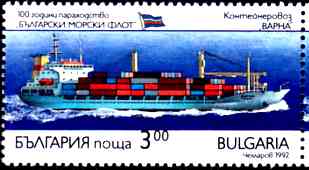
|
A few veterans of traditional break-bulk shipping are still sailing worldwide
in lesser developed regions, just as they did 40 years ago. However, most
have been scrapped and new construction is non-existent. The container age
has definitely overtaken their functions. These days, everything imaginable
gets stowed into containers, automobiles, undershirts, printed catalogs,
machine parts, marble countertops, coffee bags, oranges... There’s a lot
that can be told about them:
Click on our page covering the successors to the general cargo freighters:
Containerships!
|
|